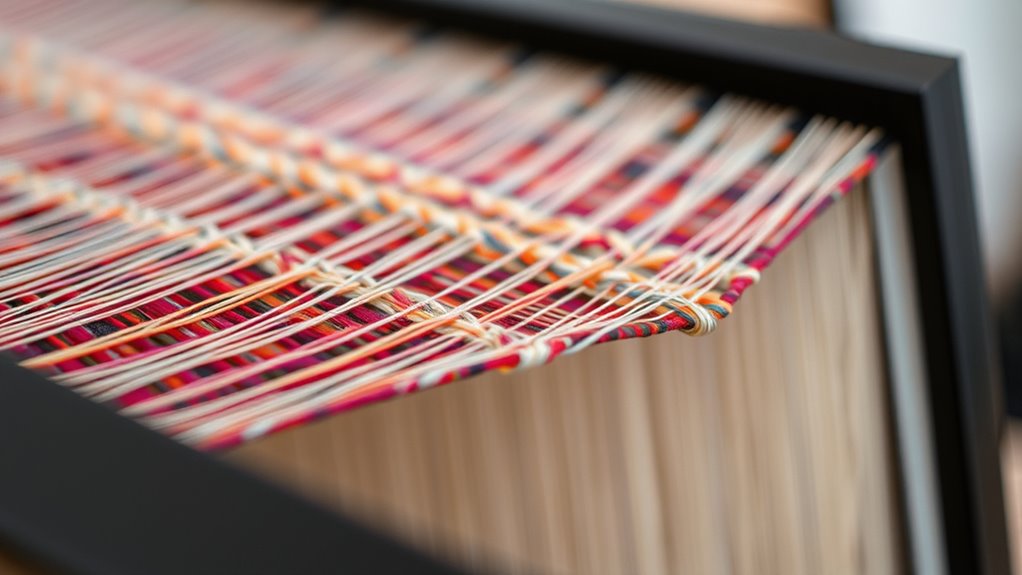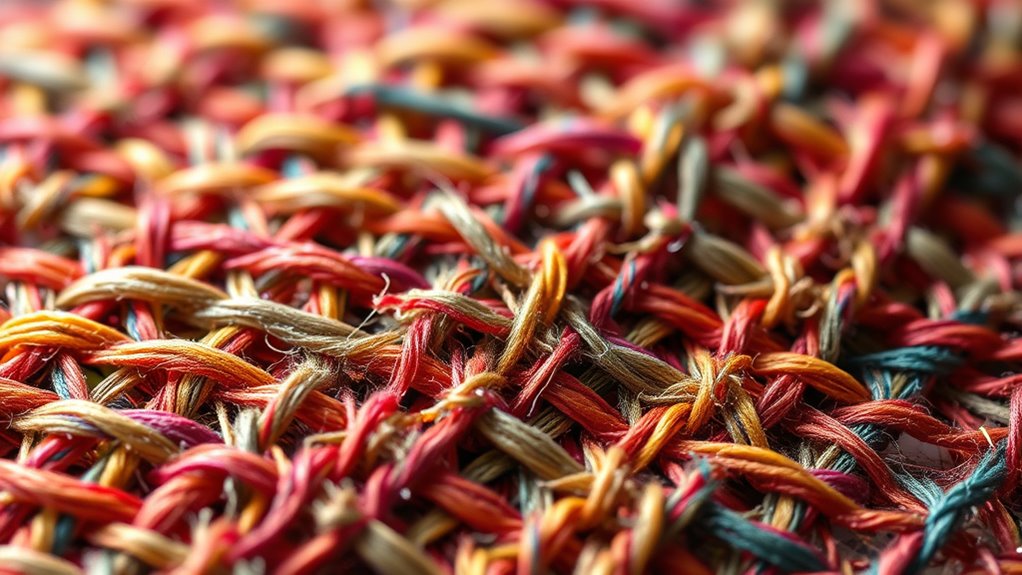When framing textiles, you should prioritize UV-filtering glass or acrylic to protect against fading, use acid-free mats and backing to prevent deterioration, and avoid adhesives or staples that can cause damage. Opt for proper mounting techniques that minimize stress on the fabric, and control lighting and environment to prevent fading and mold. Choosing supportive, inert framing materials enhances both preservation and appearance. To guarantee your textile’s long-term care, explore these considerations in more detail.
Key Takeaways
- Use acid-free, archival-quality mats and backing to prevent chemical deterioration of textiles.
- Avoid adhesives and staples; prefer sewing or cradle mounting techniques to reduce stress.
- Incorporate UV-filtering glass or acrylic to protect textiles from fading and discoloration.
- Control lighting and environmental conditions to prevent fading, mold, and fiber degradation.
- Select inert framing materials that enhance aesthetic appeal without risking chemical reactions or damage.

When selecting a textile frame, understanding the key considerations can make all the difference in ensuring your artwork remains protected and visually striking. One of the most important factors is safeguarding your textiles from UV damage. Ultraviolet rays can cause fading, discoloration, and deterioration over time, so choosing framing materials with UV protection is essential. Look for UV-filtering glass or acrylic, which blocks out harmful rays while still allowing your artwork to be viewed clearly. This added layer of protection helps preserve the vibrancy and integrity of your textile, ensuring it looks fresh for years to come.
Protect textiles from UV rays with UV-filtering glass or acrylic to preserve their vibrancy.
Next, you need to carefully consider the framing materials themselves. Not all materials are suitable for textiles, as some can cause damage or degrade over time. Acid-free and archival-quality materials are your best bet. Acid-free mats and backing boards prevent acids from migrating into the textile, which could lead to deterioration. When selecting the frame, opt for materials like wood, aluminum, or other non-reactive substances that won’t emit harmful chemicals or cause discoloration. The framing material should also be sturdy enough to support the textile without warping or bending, especially if your piece is large.
The method of mounting your textile is another critical consideration. You want to avoid stretching or putting undue stress on the fabric, which could distort or damage it. Many conservators recommend mounting textiles using a method that minimizes contact with adhesives or staples, such as sewing or using a cradle system. This approach helps maintain the textile’s shape and prevents any chemical reactions from adhesives that could harm the fibers over time. Additionally, proper climate control in the display environment helps prevent issues like mold or fabric degradation caused by humidity and temperature fluctuations.
In addition, lighting conditions in the display environment play a role in the longevity of your textile. Besides UV protection, you should also consider controlling light exposure, avoiding direct sunlight and bright artificial lights. Proper lighting helps prevent fading and maintains the textile’s vibrant colors.
Finally, think about the overall aesthetic and presentation. Your framing choices should complement the textile without overpowering it. The frame should enhance the artwork’s visual appeal while providing the necessary protection. Selecting the right framing materials—preferably those that are inert and UV protective—ensures your textile remains both beautiful and well-preserved. When you pay attention to these key considerations, your textile artwork will be well-protected, allowing its beauty to shine through for many years.
Frequently Asked Questions
What Are the Best Storage Conditions for Framed Textiles?
You should store framed textiles in a cool, dry place away from direct sunlight. Make certain there’s UV protection to prevent fading and discoloration over time. Maintain consistent humidity control, ideally between 45-55%, to avoid mold growth or warping. Keep the textiles away from fluctuating temperatures and pests. Proper storage preserves their appearance and integrity, so handle them carefully and consider using acid-free materials for added protection.
How Can I Prevent Fading of Textiles Over Time?
Imagine your textiles as treasures that need guarding. To prevent fading over time, you should guarantee they’re protected from UV rays—think of UV protection as an invisible shield. Use acid-free materials for framing and storage, which act like gentle guardians, neutralizing acids that cause deterioration. Keep textiles away from direct sunlight, high humidity, and fluctuating temperatures. Regularly inspect and handle them with clean gloves to preserve their vibrant colors for generations.
Are There Eco-Friendly Framing Materials Available?
You can choose eco-friendly framing materials by opting for recycled framing options that reduce waste and environmental impact. Look for frames made from sustainably sourced or recycled materials, and use eco-friendly adhesives that are non-toxic and biodegradable. These choices help minimize your carbon footprint while protecting your textiles. By selecting environmentally conscious options, you support sustainability and guarantee your framing process is eco-friendly.
How Often Should Framed Textiles Be Inspected?
Inspecting your framed textiles is like caring for a delicate garden; regular attention keeps it thriving. You should check them at least once a year, more often if environmental conditions fluctuate. Environmental monitoring helps identify issues early, while pest prevention ensures no damage occurs. Regular inspections allow you to spot signs of deterioration or pests, preserving your textiles’ integrity and beauty for years to come.
Can Framing Techniques Damage Delicate Textiles?
Yes, framing techniques can damage delicate textiles if you’re not careful. Using improper framing adhesives can cause staining or deterioration over time, and glass protection that isn’t properly fitted might exert pressure or cause abrasion. To avoid damage, choose acid-free mats and adhesives designed for textiles, and verify the glass is UV-protective and well-fitted. Proper framing preserves your textile’s appearance and longevity.
Conclusion
So, when framing textiles, you hold the power to turn a simple piece into an awe-inspiring masterpiece that could stop time itself! With just the right considerations, your textile could become the crown jewel of any collection, capturing hearts and jaw-drops alike. Don’t underestimate the magic behind every choice—you’re not just preserving fabric; you’re creating a legendary legacy that will leave everyone breathless. Get ready to make history, one frame at a time!









